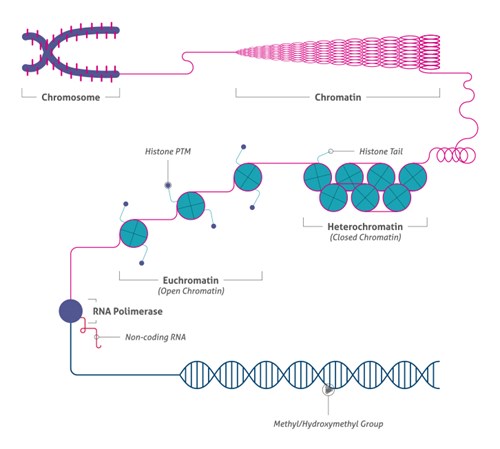Epigenetics - DNA layers and chromatin modeling
Introduction to Epigenetics
In 1942, epigenetics was first described by Conrad Hal Waddington (1) as “the causal interactions between genes and their products, which bring the phenotype into being.” Today, however, it is described as the study of heritable changes in chromatin that appear independently of changes in the primary DNA sequence (2).
Types of chromatin
The DNA molecule inside the nucleus is packed into chromatin that consists of nucleosomes wrapping 146 base pairs (bp) of DNA around an octamer of four core histones (H2A, H2B, H3, and H4) (3). There are two types of chromatin; euchromatin and heterochromatin.
- The euchromatin (open chromatin) is permissive chromatin, which may be transcriptionally active or inactive.
- Heterochromatin (closed chromatin) is condensed and transcriptionally silent. It can be in a permanent state of silence, known as constitutive heterochromatin, or potentially dynamic, known as facultative heterochromatin.
Because of this, we have a spectrum of chromatin states, thereby suggesting that chromatin has a great deal of plasticity.
Chromatin modification
The organization of the chromatin can be modified by epigenetic mechanisms to create unique “epigenetic landscapes” for different cell types, resulting in unique properties and distribution patterns for expression (4). The chromosomal plasticity mentioned in Adrian Bird’s definition could not occur if the DNA were to exist in a “naked state” (5).
Figure 1 provides a visual representation of the layer of covalent modifications added to the eukaryotic DNA, as well as the proteins and RNAs that can themselves be modified, all of which contribute to a layer of chemical complexity and significant implications that epigenetics strives to classify and comprehend.
 |
|
Figure 1. Different layers of compaction eukaryotic DNA. |
Chromatin diseases
Chromatin diseases are an outcome of genetic pathologies resulting from mutations in structural components of chromatin or in enzymes that biochemically modify chromatin, thereby having drastic effects on gene expression (6). Chromatin diseases frequency range from very rare to quite common; to date, for the majority of them, no treatment is yet available.
Molecular studies on these pathologies have a twofold value: to shed light on the intricate interplays between various levels of control of gene expression acting in the mammalian nucleus, and to pave the way for new and more effective strategies to approach their clinical treatment.
Related products
| HDAC4 | KD/KO Validated | HDAC8 | 8 Publications |
| HDAC4-Specific | KD/KO Validated | HDAC6 | 7 Publications |
| HDAC1 | KD/KO Validated | HDAC5-Specific | 3 Publications |
| HDAC3 | KD/KO Validated | HDAC2-Specific | ELISA, WB, IP, IHC, IF |
| HDAC2 | KD/KO Validated | HDAC1-Specific | ELISA, WB, IP, IF |





